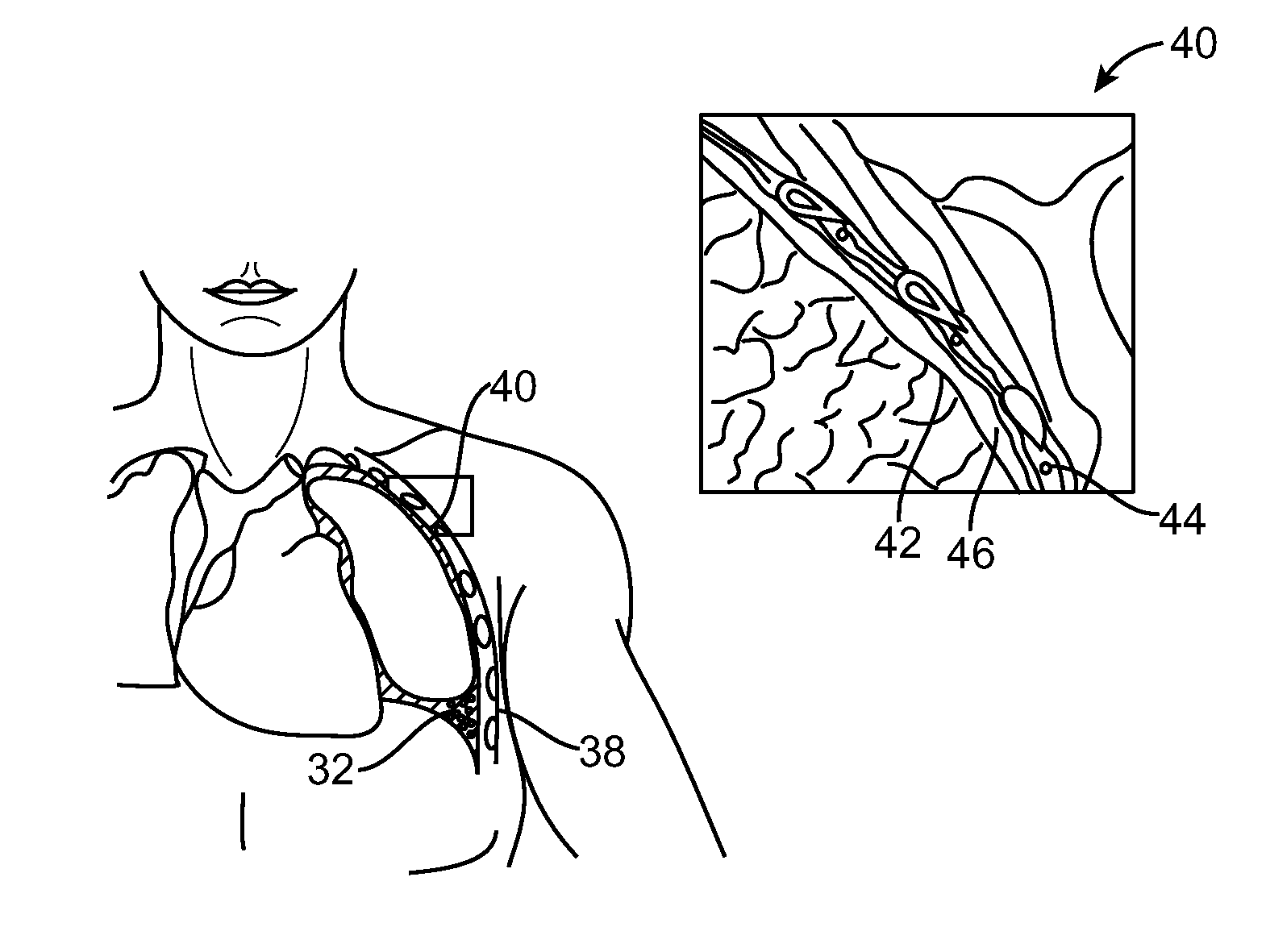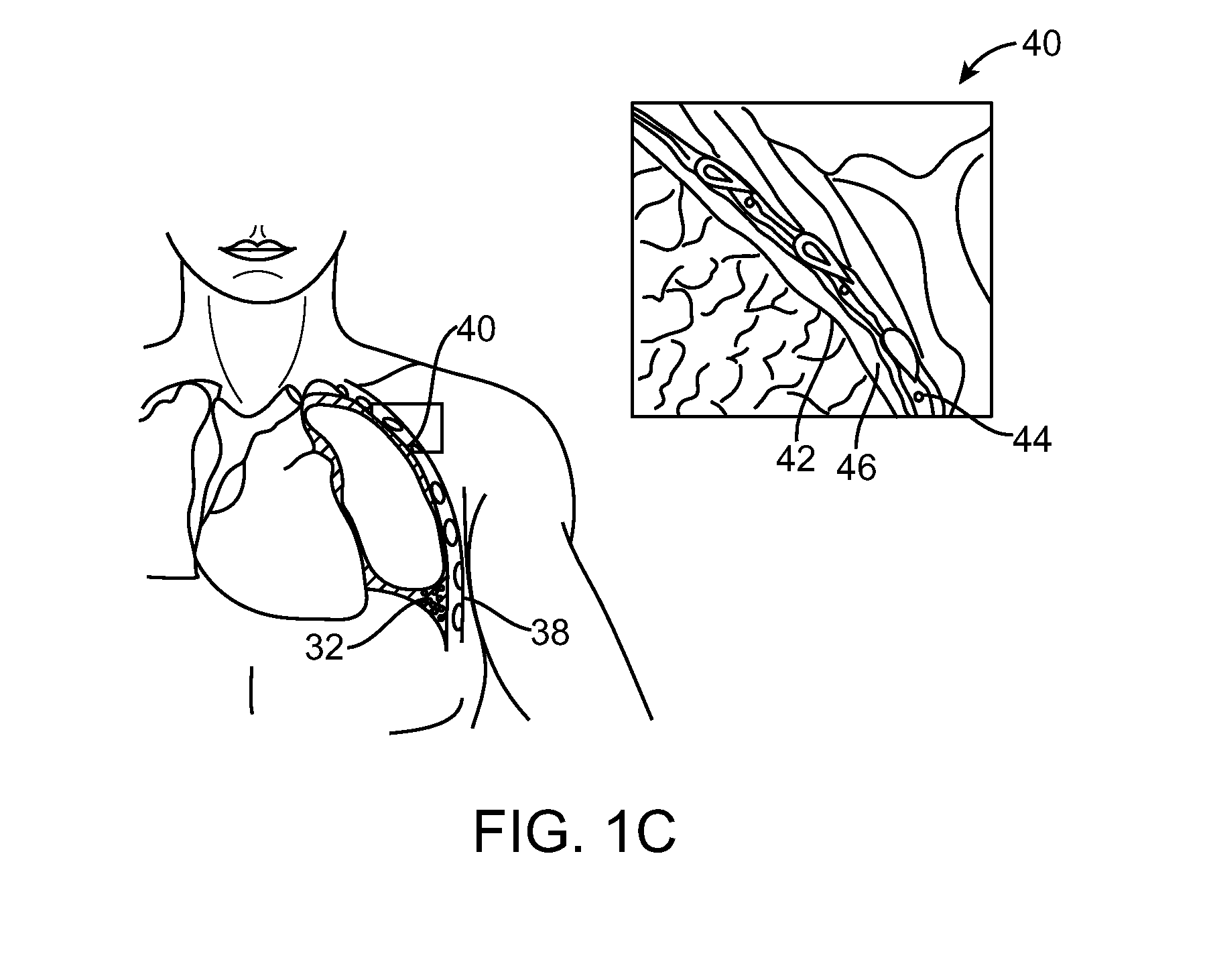[0016]In many embodiments, a third airway axial region is urged laterally toward a fourth airway axial region from within third and forth airway axial regions, respectively. These airway axial regions may be manipulated by additional portions of the same elongate body, or by using a separate elongate body implanted within the lung. Advantageously, the compressed volume of
lung tissue may be sufficiently large and may be compressed sufficiently to increase tension in an uncompressed volume of the lung such that
lung function of the lung is increased.
[0019]An intermediate elongate body portion may couple the first elongate body portion to the second elongate body portion Hence, these elongate body portions may be included within a continuous elongate body. The elongate body can be biased to bend from the first configuration to the second configuration so as to compress the
lung tissue volume. Advantageously, compression can be effected atraumatically by urging an elongate
bearing surface of the elongate body laterally against an airway lumen surface so as to impose a bend in the airway
system between (and optionally along) the airway axial regions. The
bearing surface need not be continuous, and may have an overall size sufficient to inhibit penetration through the airway surface during deployment of the elongate body. A third elongate body portion may be coupled to the first and second body portions. Analogous to the description above regarding three-dimensional compression of the lung tissue, a surface can be defined between the first and second local axes when the
implant is in the second configuration. The implant in the second configuration is configured to urge a third airway axial region toward the surface from within the third airway axial region so that the compressed volume of lung tissue is disposed at least in part between the surface and the third airway axial region. In some embodiments, the implant comprises a fourth elongate body portion coupled to the
third body portion so as to urge a fourth airway axial region toward the first, second, and third airway axial regions when the implant is in the second configuration. The compressed lung
tissue volume is disposed therebetween, with some or all of the remaining tissue of the lung thereby gaining therapeutically beneficial tension.
[0020]The compressed volume of lung tissue may be sufficiently large and may be compressed sufficiently to increase tension in an uncompressed volume of the lung such that
lung function of the lung is increased.
[0025]The design of the device facilitates
strain relief on both ends of the device. Further the ends of the device in either the delivery or deployed state are more resilient.
[0040]Pursuant to another method of the invention, a method of bending a lung airway of a patient is provided comprising inserting a device into the airway in a delivery configuration and bending the device into a deployed configuration to reduce the
radius of curvature of at least a portion the airway.
[0041]Still another method of the invention provides a method of bending a lung airway of a patient comprising inserting an implantable device into the airway in a delivery configuration and bending the device into a deployed configuration to reduce the
radius of curvature of at least a portion the airway. In an embodiment, the step of bending can further comprise operating an
actuator outside the patient, the
actuator being operatively connected to the device. In yet another embodiment, the step of bending further comprising locking the device into the deployed configuration. In still another embodiment, the step of bending further comprises unlocking the device to permit it to return to the delivery configuration. Additionally, in some embodiments, the step of bending can further comprise disconnecting the
actuator from the device. Suitable devices for the methods of the invention include devices that comprise a plurality of asymmetric segments, inserting comprises delivering the plurality of asymmetric segments to the airway as well as devices comprising shape memory material. Additionally, the step of bending can further comprise rotating at least one asymmetric segment with respect to at least another asymmetric segment. An additional step of some embodiments of the method can further comprise delivering a
catheter and delivering a shape memory element through the
catheter. After delivery of the device, according to the methods provided, the device can then bend into a substantially C shape, S shape, spiral shape, coil shape of one or more radiuses, as well as any shape that is within one or more planes. In an additional embodiment of the method, the step of inserting further comprises delivering the device through a working channel of a bronchoscope. In yet another step of the method, the method further comprises retrieving the device from the airway. Embodiments of the method can further provide the step of providing
strain relief to an end of the device during deployment. The delivery configuration of the device can be achieved by transforming
metal to a
martensite phase or by cooling the implant, such as by delivering liquids or gas. Cooled liquids or gases can be at delivered at temperatures that are at or below body temperature, are 37 degrees Celsius or lower in temperature, or at or below zero degrees Celsius. In some methods of the invention, the implant and surrounding tissues are cooled below zero degrees Celsius, or at or below minus fifteen degrees Celsius.
 Login to View More
Login to View More  Login to View More
Login to View More 


